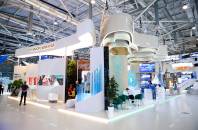|
Региональный журнал для деловых кругов Дальнего Востока
|
|
||||||||||||||||||||||
|
Четверг| 21 Ноября, 23:19 |
|
|
Тема номера
|
|||||||||||||||||||||

 Социальные предприниматели Приморья могут найти кадры и получить рекламу на радио при господдержке
Открыт прием заявок на две актуальные для социальных предпринимателей меры поддержки: "Размещение двух вакансий на HeadHunter" и "Размещение рекламы на радиостанции". Такой формат господдержки поможет социальному бизнесу Приморья продвигать свои услуги в осенний период и найти профессиональные кадры для расширения штата.
Социальные предприниматели Приморья могут найти кадры и получить рекламу на радио при господдержке
Открыт прием заявок на две актуальные для социальных предпринимателей меры поддержки: "Размещение двух вакансий на HeadHunter" и "Размещение рекламы на радиостанции". Такой формат господдержки поможет социальному бизнесу Приморья продвигать свои услуги в осенний период и найти профессиональные кадры для расширения штата.
 24 протокола составили на нарушителей противопожарного режима в приморских лесах
Лесничие и инспекторы в Приморье составили 24 протокола в отношении нарушителей особого противопожарного режима на землях лесного фонда. ОПР действует в большинстве муниципалитетов и подразумевает крупные штрафы за пренебрежение правилами пожарной безопасности.
24 протокола составили на нарушителей противопожарного режима в приморских лесах
Лесничие и инспекторы в Приморье составили 24 протокола в отношении нарушителей особого противопожарного режима на землях лесного фонда. ОПР действует в большинстве муниципалитетов и подразумевает крупные штрафы за пренебрежение правилами пожарной безопасности.
 Первый класс для подготовки связистов-профессионалов появился в Приморье
Во Владивостоке открылся первый в Приморье учебный класс для обучения технических специалистов телекоммуникационной отрасли. В нем будут проходить стажировку выпускники Промышленного колледжа энергетики и связи и других учебных заведений края.
Первый класс для подготовки связистов-профессионалов появился в Приморье
Во Владивостоке открылся первый в Приморье учебный класс для обучения технических специалистов телекоммуникационной отрасли. В нем будут проходить стажировку выпускники Промышленного колледжа энергетики и связи и других учебных заведений края.
Refinery with a view into the future
By Alexander ZUBOV
The Khabarovsk Refinery, controlled by Alliance Oil, meets about 30% of RFE demand for oil products. In its attempt to keep up with growing consumption, the refinery is increasing output. The company processed 2.6 million tons of oil in 2000, and 3.26 million tons in 2010. In 2011, the refinery processed 3.7 million tons of oil, the highest total in 17 years.
Current refining volumes are close to maximum available capacity, and although these volumes are no longer sufficient to meet the growing demand for the refinery’s output, the facility cannot continue to expand supply because of transportation and logistics bottlenecks. The Khabarovsk Refinery is the only large refinery in Russia receiving all of its inputs by rail, and rail also accounts for most shipments. Refining volumes are effectively capped by the throughput capacity of the refinery’s railroad hub.
Connecting the refinery to the ESPO oil pipeline will eliminate this bottleneck. The 26-kilometer refinery access pipeline, complete with a pumping facility, will run nearly halfway through Khabarovsk, where the pipeline can only be laid at a great depth in a microtunnel the within the city limits.
The refinery is scheduled for connection to the ESPO by late 2013-early 2014. Crude oil offtake from the pipeline will increase gradually. Initially, the refinery will receive two million tons of crude per annum from the ESPO, with the amount increasing to fill the refinery’s capacity. The pipeline will make it possible to use freed-up railroad capacity to transport refined products.
Thanks to this expansion, Alliance Oil expects to increase its refining capacity to six million metric tons per annum. Currently, Khabarovsk Refinery is implementing Stage 2 of its comprehensive upgrade, with construction of a vacuum cracking unit using Shell’s visbreaking technology to finish next year.
The refinery has completed Stage 1 of the upgrade, bringing its gasoline production processes up to date in terms of technology and quality standard. Work is under way to upgrade the kerosene and diesel fuel production lines, as expansion of gasoline production capacity continues.
“Refinery upgrades are under way nationwide, as part of Russia’s effort to catch up with the refining industry in the developed world. The average refining depth in Russia is 72% versus 85% in the EU and 92% in the US, meaning that Russian refineries get less high-grade high value-added refined petroleum products out of one ton of crude, which increases the per-unit cost of output and adversely affects pricing. This problem is especially severe for the Khabarovsk Refinery, which was built in 1935. The upgrades are intended to increase our refining depth to US refining levels,” says Khabarovsk Refinery head Viktor LEMEKHA.
Improving output quality is also necessary, given the gradual tightening of mandatory technical requirements for fuel in Russia. Production of diesel fuel with 0.2% sulfur content was banned as of last September. The country will be moving to Class 3 or higher gasoline and diesel fuel as of January 1, 2013, and to Class 4 or higher from 2015.
Many companies in the refining sector launched upgrades simultaneously and may not all complete the required modifications on time, because Russian design institutes were not prepared for this avalanche of demand (they cannot handle the volume of orders for designing upgraded refining capacity); there is also a dearth of construction companies with the right expertise, the demand for debt has also increased, and raising debt usually takes a certain amount of time.
The Khabarovsk Refinery raised its gasoline quality to European standards after the first stage of its upgrade program, but the refinery’s production of diesel fuels faces a problem: it cannot meet the higher quality standard before completing construction of the medium distillates hydrocracking and hydrotreatment (HCHT) unit scheduled for 2013.
Currently, Khabarovsk Refinery is housed in cramped quarters surrounded by buildings and businesses. When built, it was on the outskirts of the city, which has since expanded, wrapping the refinery in the city centre, New facilities are being built on a new site, with no halts in production. The construction project needs up to 1,600 workers busy on a daily basis, compared to the refinery’s operating staff of 1,500.
Alliance Oil brought in Tucnicas Reunidas, a Spanish engineering company, as general contractor in 2007 to build the HCHT unit, bringing in subcontractors from other countries. This has created a host of unexpected problems and complications and delayed bringing the new capacity on stream.
Facilities constructed by the refinery are being launched without any major problems.
“The refinery has expanded its gasoline production capacity this year, after assembling a stabilization unit at the isomerization facility, replacing the catalyst in the reactor, which should help increase isomerization intensity by 20%, says the head of the Khabarovsk Refinery. We also had a new column installed at the absorbing gas fractioning unit (AGFU), which should optimize feedstock preparation for isomerization. We have refurbished the reforming unit, increasing its capacity from 300,000 to 350,000 metric tpa. Construction is close to completion at the Refinery-2 substation to accommodate higher power consumption. We have put in refinery-wide infrastructure to support operation of the new HCHT complex.”
But with the work entrusted to the foreign general contractor, the sitation is a bit different.
“Frankly speaking, we expected a little more from this cooperation than the actual outcomes,” Victor Lemekha says. “We believed there was a lot to learn about organizing construction from a well-known European company. However, the actual experience was more of a mixed bag. The general contractor has breached several terms of the contract, which has caused the project to fall behind schedule; the general contractor also fails to follow safety regulations at the construction site.”
The experience of cooperation showed the Khabarovsk staff that local construction and installation workers can do at least as well as international experts. However, it is hard to find a sufficient number of skilled workers for such large-scale and narrowly specialized work in the Russian Far East.
Nevertheless, the problems with foreign construction workers do not imply overall disappointment in international cooperation. The refinery upgrade project involves implementation of state-of-the-art technologies, most of which have been supplied by Shell, a company Alliance Oil has been working with for the past several years.
“Everything is just perfect here,” says Victor Lemekha, speaking for the whole team.
Overall, the ongoing stage of the refinery upgrade will cost nearly RUB 36 billion for the shareholders. Another RUB 7 billion was invested in the first stage of the upgrade, but the RUB 43 billion does not include the cost of connecting the refinery to the ESPO pipeline. A final design has not yet been approved, but the cost of this project is also estimated at several billion rubles. However, Alliance Oil is determined to raise the capital, realizing very well that without a local industry, without local resource processing capacity, there is no future for the Russian Far East.
- Дальневосточный фокус. Как делать бизнес на Дальнем Востоке?
- Дрейф в штиль. Куда идет дальневосточный бизнес
- Акцент на береговую зону
- "РЖД" берет повышенный план
- Банки сняли отраслевые барьеры малому бизнесу на Дальнем Востоке
- Рейтинг 100 крупнейших компаний Дальнего Востока по выручке и темпам роста показывает реальные дела
- Рецепты выживания: Рейтинг эффективности бизнеса 100 крупнейших компаний Дальнего Востока
- По "Улице Дальнего Востока" с любопытством и восторгом
- Проект "Приморский маршрут": Приморский край: есть чем впечатлиться
- ТОП крупнейших компаний Дальнего Востока расширился до 150
 Более 370 тысяч приморцев уже прошли диспансеризацию в этом году
В Приморском крае продолжается кампания по проведению диспансеризации и профилактических осмотров взрослого населения. В ней задействованы специалисты 45 медицинских организаций, которые работают на всей территории региона. А с 20 сентября по 20 декабря будет действовать акция "Диспансеризация за час".
Более 370 тысяч приморцев уже прошли диспансеризацию в этом году
В Приморском крае продолжается кампания по проведению диспансеризации и профилактических осмотров взрослого населения. В ней задействованы специалисты 45 медицинских организаций, которые работают на всей территории региона. А с 20 сентября по 20 декабря будет действовать акция "Диспансеризация за час".





